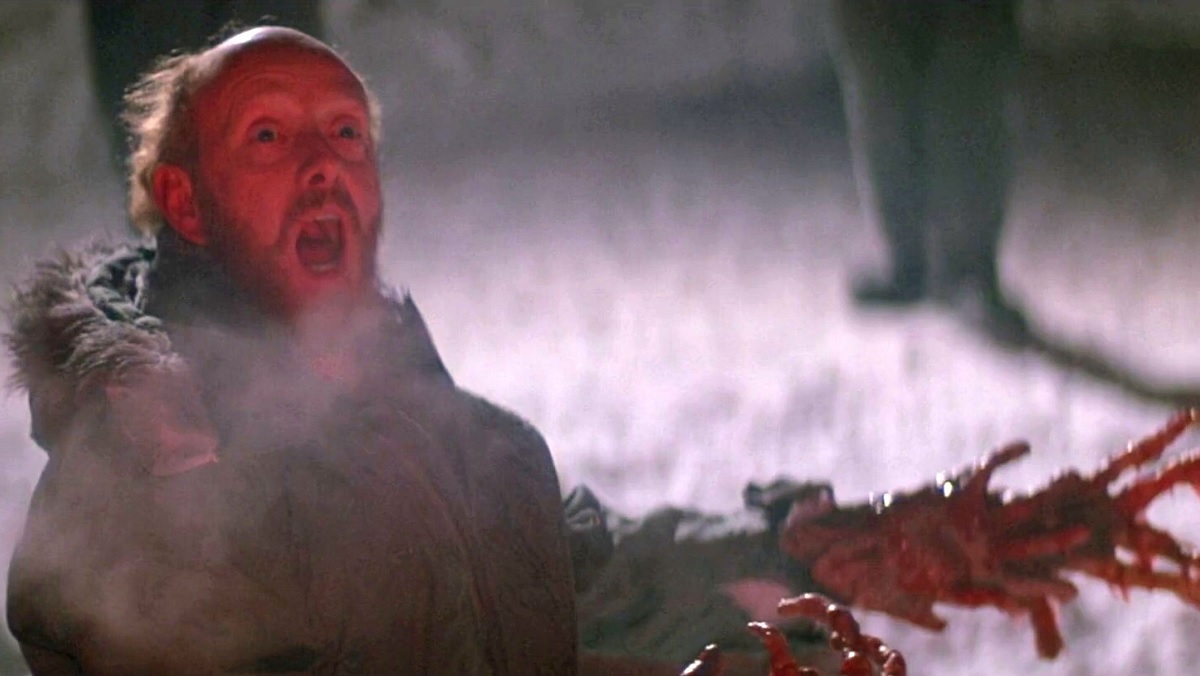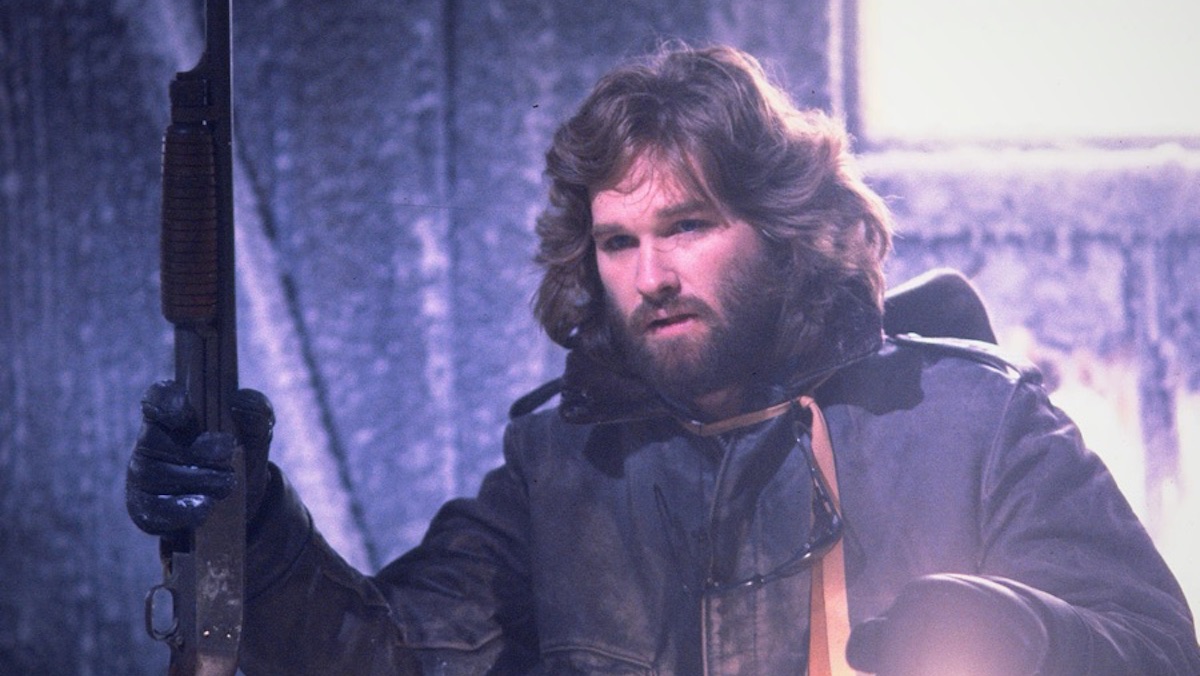
It’s officially spooky season, meaning it’s time for costumes, Halloween decorations, and, of course, scary movie marathons! But when we watch horror films, we often wonder how much of what we see is real. John Carpenter’s *The Thing* (1982) – a personal favorite of mine – really plays on that unsettling feeling.
Even after more than 40 years, *The Thing* still feels impactful because the true horror isn’t the monster itself—it’s the feeling of unease and not knowing what’s real. In today’s world of artificial intelligence, convincing fake videos, and widespread online misinformation, the movie’s themes might actually resonate *more* strongly now than when it was released in 1982. Things have gotten to the point where incredibly realistic-looking fake videos—like one of Stephen Hawking in a wrestling match—are now commonplace.
John Carpenter’s *The Thing* creates a terrifying atmosphere of isolation at an Antarctic research station, where a group of men find themselves trapped with a shapeshifting alien. The film doesn’t offer easy answers or a simple backstory; instead, it focuses on the breakdown of trust and the rise of paranoia. This makes the film truly frightening, as the real horror comes not from the creature itself, but from the fear of not knowing who – or what – is truly human. Carpenter brilliantly understood that the most terrifying monsters are the ones that erode our sense of certainty.
Paranoia in the Snow vs. Paranoia Online
The film’s suspense came from the creature’s ability to perfectly imitate people, right down to their mannerisms. It was a clever idea, especially considering the time – before the internet – and it felt like director Carpenter foreshadowed the problem of misinformation, even before we had a name for it.
By 2025, life feels strangely isolating despite being constantly connected. We endlessly scroll through online content, but almost 60% of us doubt what we see is even genuine. Deepfakes – realistic but fabricated videos and images – exploded in popularity between 2019 and 2020, increasing by 900%, and the trend continues. Any post, video, or profile could be a convincing imitation created by artificial intelligence. The feeling of mistrust that once haunted remote, isolated locations now exists right in our pockets, on our phones.
It’s interesting to consider that if *The Thing* came out now, some people might see it as a story about artificial intelligence and hidden code, interpreting the creatures as impostors within a system. But that’s what makes the film so brilliant – it explored those themes long before AI became a mainstream concern.
Blood Tests and Deepfakes
As a huge movie fan, I always get chills during the blood test scene in *The Thing*. It’s just so tense! Everyone’s strapped to a chair, and you can feel the desperation as they try to figure out who’s been taken over by the creature. The silence is deafening – you can practically hear everyone holding their breath, waiting to see if the blood reacts. Kurt Russell as MacReady is doing his best to lead the investigation, but honestly, nobody trusts anyone, and that makes it even more gripping.
I’ve been thinking about how we check if things are true these days. It’s not like the old stories of using hot metal to test blood – now it’s all about fact-checking websites, doing reverse image searches, and scrolling through the comments on viral videos, or even just hitting up Wikipedia. Honestly, Wikipedia often seems to cause *more* problems than it solves! But it got me thinking – we’re all still doing the same thing people did centuries ago, really. We’re constantly asking, ‘Is this actually real?’ and demanding proof, just like in that old experiment Carpenter did. It’s a never-ending quest for verification.
Unlike researchers in Antarctica who have solid proof, we don’t have definitive evidence yet. As AI creates voices that sound exactly like people we know and deepfakes manipulate what seems real, we’re facing a new kind of unsettling cultural phenomenon – one that goes beyond simple frights. This makes us prone to jumping to incorrect conclusions and believing in illusions, which can be seriously damaging.
A recent 2024 survey found that most Americans (75%) have less trust in the internet than before. A large majority (78%) also say it’s getting harder to tell what’s real and what’s been created by artificial intelligence. Interestingly, people are only able to correctly identify fake images about 62% of the time. This difference shows how difficult it’s becoming to know what’s genuine online, with so much content now being artificially created.
The Prequel’s Tragic End: A Reminder We Never Learn
Often overlooked, the 2011 prequel actually helps us understand the creature and where it truly comes from. By showing what happened at the Norwegian camp, it powerfully demonstrates that even intelligence and careful planning aren’t enough to protect you from growing fear. It’s striking because this team knew even more about identifying the infected – the creature couldn’t copy anything non-living. You can research, study, and fully grasp the danger, but still succumb to panic, which doesn’t follow logical rules.
We’re now very aware that false information is a problem. It’s influenced elections, sparked conspiracy theories, and caused division within families. Despite this, it continues to spread rapidly. Similar to a virus, distrust doesn’t require a logical cause – it simply needs someone to believe and share it.
Both films are remarkable in how subtly they portray a sense of hopelessness. There are no dramatic outbursts or speeches about the apocalypse – people simply focus on surviving using their current understanding. It’s similar to how misinformation spreads: characters are constantly trying to contain it before it escalates and becomes uncontrollable.

The Thing Is Us?
What makes *The Thing* truly terrifying isn’t any specific goal or reason – it doesn’t punish wrongdoing like some horror villains, nor does it prey on past trauma. It simply *exists*, with no sense of right or wrong. This lack of motive is what makes it so unsettling and memorable. It embodies the fear of the unknown, the idea that danger could be disguised as someone you trust – a friend, a family member, or even someone you admire.
John Carpenter ends his film with a famously unsettling scene: MacReady and Childs huddle together in the freezing cold, both questioning if the other is still human. They pass a bottle back and forth, their distrust remaining. There’s no clear ending, no victory – only a feeling of unease that stays with you.
“Why don’t we just wait here for a little while,” MacReady says, “see what happens.”
Honestly, that’s how I feel a lot of the time. Just stuck waiting, endlessly scrolling through my phone, and hoping things aren’t changing for the worse without me even noticing. It’s like, are things slipping away while we’re all distracted?
Yes, The Thing Still Matters in 2025… And Beyond
Rather than evoking fond memories, *The Thing* is a stark look at how quickly trust can break down. In today’s world of social media and echo chambers, the film shows us how easily suspicion can divide us and lead to misjudgment. It highlights how fear can overwhelm reason. The real horror isn’t the alien itself, but the possibility that we’ll lose our ability to recognize who our fellow humans truly are.
The most important thing is to remain true to ourselves, resisting the influence of AI, deceptive deepfakes, and anything that tries to create division and fear.
Read More
- 🚀 Doge’s Zero-Hour: Will It Go From Hero to Zero? 😱
- D-Wave Quantum Stock: A Curious Rise in the Tech Cosmos
- STX PREDICTION. STX cryptocurrency
- Sanctions Turn Russia’s Crypto Ban into a World-Class Gimmick! 🤑
- Calumet’s Exit: A $7M Omen for the Struggling
- Actor James Ransone Has Passed Away, Age 46
- Gold Rate Forecast
- Galaxy Digital’s 40% Plunge and a $4.7M Bet
- Billionaire’s Crypto Shuffle: What IS He Up To?! 🧐
- 🚨 Bitcoin’s Quantum Doom: 2028 or Bust? 🧪
2025-10-15 15:04